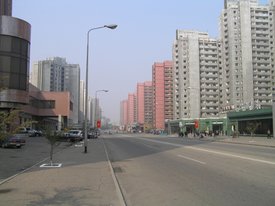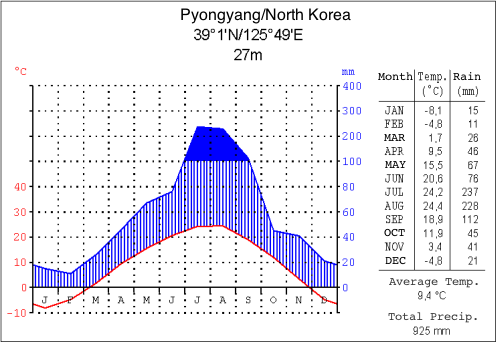Pyongyang
|
|
Template:Infobox North Korean city P'yŏngyang (Pyeongyang) is the capital city of North Korea, located in the northwest of the country, situated on the Taedong River. The official population of the city is not disclosed; given as 2,741,260 in 1993, it was reported as 2.5 and 3.8 million in 2002 and 2003 by the General Association of Korean Residents in Japan, a pro-North Korean organization. Pyongyang is located at 39°2' North, 125°45' East (39.0333, 125.75).
The city was split from the South P'yŏngan province in 1946. It is administered as a Directly Governed City (Chikhalsi), on the same level as provincial governments, not a Special City (Teukbyeolsi) as Seoul is in South Korea. Some sources, mostly older and South Korean, refer to Pyongyang as a Special City, but it has been reported that even the South Korean government adopted the Directly Governed City terminology in 1994.
| Contents |
History
According to legend, the city was founded in 2333 BC as Wanggŏmsŏng (왕검성; 王儉城). It became a major city under the Go-Joseon Dynasty.
Goguryeo moved its capital here in 427. The Tang Empire and Silla allied and defeated Goguryeo in 668. In 676 it was taken by Silla but left in the border between Silla and Balhae until the Goryeo dynasty, when the city was revived as Sŏgyŏng (서경; 西京; "western capital," although never actually a capital of Goryeo). It was the provincial capital of the P'yŏngan Province during the Joseon Dynasty, becoming provincial capital of South P'yŏngan Province from 1896 and through the period of Japanese rule.
In 1945, Japanese rule ended and it was occupied by Soviet forces, and became the temporary capital of the Democratic People's Republic of Korea at its establishment in 1948 while it aims to recapture its official capital at that time of Seoul. It was severely damaged in the Korean War, during which it was briefly occupied by South Korean forces. After the war, the city was quickly rebuilt with Soviet help, with many buildings built in Stalinist architecture.
Historic names
One of its many historic names is Ryugyŏng (류경; 柳京), or "capital of willows", as willow trees have always been numerous throughout the city's history, and many poems written about these willows. Even today, Pyongyang has numerous willow trees planted everywhere, and many buildings and places are named with "Ryugyŏng", the most notable of all being its uncompleted Ryugyong Hotel. Its other historic names include Kisŏng, Hwangsŏng, Rangnang, Sŏgyŏng, Sŏdo, Hogyŏng, Changan, etc.
Administrative divisions
P'yŏngyang is divided into 19 wards ("Kuyŏk") and 4 counties ("Kun").
- Chung-guyŏk (중구역; 中區域)
- P'yŏngch'ŏn-guyŏk (평천구역; 平川區域)
- Pot'onggang-guyŏk (보통강구역; 普通江區域)
- Moranbong-guyŏk (모란봉구역; 牡丹峰區域)
- Sŏsŏng-guyŏk (서성구역; 西城區域)
- Sŏn'gyo-guyŏk (선교구역; 船橋區域)
- Tongdaewŏn-guyŏk (동대원구역; 東大院區域)
- Taedonggang-guyŏk (대동강구역; 大同江區域)
- Sadong-guyŏk (사동구역; 寺洞區域)
- Taesŏng-guyŏk (대성구역; 大城區域)
- Man'gyŏngdae-guyŏk (만경대구역; 萬景台區域)
- Hyŏngjesan-guyŏk (형제산구역; 兄弟山區域)
- Ryongsŏng-guyŏk (룡성구역; 龍城區域)
- Samsŏk-guyŏk (삼석구역; 三石區域)
- Sŭngho-guyŏk (승호구역; 勝湖區域)
- Ryŏkp'o-guyŏk (력포구역; 力浦區域)
- Rangnang-guyŏk (락랑구역; 樂浪區域)
- Sunan-guyŏk (순안구역; 順安區域)
- Ŭnjŏng-guyŏk (은정구역; 恩情區域)
- Chunghwa-gun (중화군; 中和郡)
- Kangnam-gun (강남군; 江南郡)
- Kangdong-gun (강동군; 江東郡)
- Sangwŏn-gun (상원군; 祥原郡)
Landmarks
The capital has been completely rebuilt since the Korean War (1950–1953). It is designed as a showcase for the communist revolution, with wide avenues, imposing monuments, and monolithic buildings. The tallest structure in the city is the uncompleted 1,080-foot Ryugyong Hotel. This hotel has 105 floors with a few pavilions for rotating restaurants; however, construction has been stalled since the early 1990s. The building stands now as an empty shell.
Some notable landmarks in the city include the Arch of Triumph (a larger replica of Paris's Arc de Triomphe), the reputed birthplace of Kim Il Sung at Mangyongdae Hill, Juche Tower, and two of the world's largest stadiums (Kim Il Sung Stadium and Rungnado May Day Stadium).
Transportation
Pyongyangmetro.png
Metro
Pyongyang has a two-line underground metro system which has a length of 22.5 km. There is also a tram and trolleybus service. There are not as many private automobiles as in Western cities, although the state government operates a sizable fleet of Mercedes-Benz limousines for Party bureaucrats. Many residents walk, cycle, or use the subway because of lack of other options for transportation.
Pyongyang is served by Sunan Capital International Airport, which has weekly flights to Beijing (PEK), Shenyang (SHE), Vladivostok (VVO) and several other cities. There are occasional chartered flights to Macau (MFM), Bangkok (BKK), Incheon (ICN), Yangyang County (YNY) and several Japanese cities. The city also has regular international train service to Beijing and Moscow. A journey for Beijing taking about 24 hours; Moscow, 6 days.
Climate
References
- 행정 구역 현황 (Haengjeong Guyeok Hyeonhwang) (http://nk.chosun.com/map/map.html?ACT=geo_01) (in Korean only)
- Administrative divisions of North Korea (http://www.xzqh.org/waiguo/asia/1002.htm) (in simplified Chinese; used as reference for Hanja)
See also
External links
- Pictures from Pyongyang (http://www.michaeljennings.de/content/dprk.htm)
- Travel-Images.com - DPRK (http://www.travel-images.com/korean.html) - images of Pyongyang
- Pyongyang Metro (unofficial website-1) (http://www.pyongyang-metro.com)
- Pyongyang Metro (unofficial website-2) (http://hk.geocities.com/hkgalbert/pyongyang_metro.htm)
- Pyongyang Sunan International Airport(FNJ)(unofficial website) (http://hk.geocities.com/hkgalbert/fnj.htm)
- Travel Info of Democratic People's Republic of Korea (http://hk.geocities.com/hkgalbert/jskorea01.htm)
- Korea Tourist Map (http://uk.geocities.com/hkgalbert/kpmap.htm)
- Korean Musicals) (http://www.angelfire.com/folk/ukgalbert/index.html)
- Diplomatic Mission List of DPRK (unofficial website) (http://uk.geocities.com/hkgalbert/kphome.htm)
| Administrative divisions of North Korea | Missing image North_korea_flag_large.png Flag of North Korea |
|---|---|
| Directly Governed Cities P'yŏngyang | Rasŏn | |
| Former Directly Governed Cities | |
| Special Administrative Regions Kaesŏng Industrial Region | Kŭmgangsan Tourist Region | Sinŭiju Special Administrative Region | |
| Provinces Chagang | North Hamgyŏng | South Hamgyŏng | North Hwanghae | South Hwanghae | Kangwŏn | North P'yŏngan | South P'yŏngan | Ryanggang | |
es:Pyongyang fr:Pyongyang ko:평양직할시 hi:प्योंगयांग io:Pyongyang id:Pyongyang it:Pyongyang he:פיונגיאנג nl:Pyongyang ja:平壌 pl:Phenian pt:Pyongyang ru:Пхеньян sk:Pchjongjang fi:Pjongjang sv:Pyongyang zh:平壤


